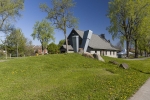Pierre Leblanc
Pont d'Arles en transfert
1985
Presentation of the artwork
The work was created specifically to be integrated into the outdoor site at the Musée de Lachine, as evidenced by the encrustation of the low wall into the grade difference in the ground. At the top of the small hill supported by the wall are two metal beams, painted grey-blue, that seem to be planted at an angle in the ground. Passing between the two beams are a series of large stones tracing a line from west to east on the talus.Leblanc produced this work when he returned from a trip to Arles, France. It refers to the bridge in Arles once called Pont de Langlois. A number of the artist’s works are related to the history of art and of literature. Here, following Vincent Van Gogh, he appropriated a subject (the bridge) and explored its visual possibilities. Although van Gogh concentrated on the colour when he painted Pont Langlois under different lighting conditions, Leblanc, a century later, made a transformation in his turn, and the wood beams became steel beams. The subject is reinterpreted according to the concerns of a sculptor who is interested in the physical properties of materials, raw or processed, construction and assembly techniques, and the laws that govern them: strength and pressure, torque, weight and support, tension, and compression.
Associated events
The artwork was created for the first Lachine, Carrefour de l’Art et de l’Industrie sculpture symposium in the summer of 1985. Organized by the Société de diffusion internationale et de placement sur œuvres d’art (Sodip-Art), the event brought together eight sculptors each of whom produced a monumental sculpture on site as the public watched.
Pierre Leblanc
Pierre Leblanc was born in Montréal and has lived and worked in Val-David since 1974. He received his initiation to sculpture at the Fonderie expérimentale de Pierrefonds, where he worked alongside sculptors André Fournelle and Armand Vaillancourt.
His artworks are exhibited regularly in North America and Europe and are in a number of public collections, including the Musée du Bas-Saint-Laurent, the Musée national des beaux-arts du Québec, and the Musée d’art contemporain de Montréal. In 2011, le Musée d’art contemporain des Laurentides presented Signes et repères, a solo exhibition of his recent works. Leblanc has also produced many public art projects throughout Québec.
His artworks are exhibited regularly in North America and Europe and are in a number of public collections, including the Musée du Bas-Saint-Laurent, the Musée national des beaux-arts du Québec, and the Musée d’art contemporain de Montréal. In 2011, le Musée d’art contemporain des Laurentides presented Signes et repères, a solo exhibition of his recent works. Leblanc has also produced many public art projects throughout Québec.
Presentation of the artwork
The work was created specifically to be integrated into the outdoor site at the Musée de Lachine, as evidenced by the encrustation of the low wall into the grade difference in the ground. At the top of the small hill supported by the wall are two metal beams, painted grey-blue, that seem to be planted at an angle in the ground. Passing between the two beams are a series of large stones tracing a line from west to east on the talus.Leblanc produced this work when he returned from a trip to Arles, France. It refers to the bridge in Arles once called Pont de Langlois. A number of the artist’s works are related to the history of art and of literature. Here, following Vincent Van Gogh, he appropriated a subject (the bridge) and explored its visual possibilities. Although van Gogh concentrated on the colour when he painted Pont Langlois under different lighting conditions, Leblanc, a century later, made a transformation in his turn, and the wood beams became steel beams. The subject is reinterpreted according to the concerns of a sculptor who is interested in the physical properties of materials, raw or processed, construction and assembly techniques, and the laws that govern them: strength and pressure, torque, weight and support, tension, and compression.
Associated events
The artwork was created for the first Lachine, Carrefour de l’Art et de l’Industrie sculpture symposium in the summer of 1985. Organized by the Société de diffusion internationale et de placement sur œuvres d’art (Sodip-Art), the event brought together eight sculptors each of whom produced a monumental sculpture on site as the public watched.
Pierre Leblanc
Pierre Leblanc was born in Montréal and has lived and worked in Val-David since 1974. He received his initiation to sculpture at the Fonderie expérimentale de Pierrefonds, where he worked alongside sculptors André Fournelle and Armand Vaillancourt.
His artworks are exhibited regularly in North America and Europe and are in a number of public collections, including the Musée du Bas-Saint-Laurent, the Musée national des beaux-arts du Québec, and the Musée d’art contemporain de Montréal. In 2011, le Musée d’art contemporain des Laurentides presented Signes et repères, a solo exhibition of his recent works. Leblanc has also produced many public art projects throughout Québec.
His artworks are exhibited regularly in North America and Europe and are in a number of public collections, including the Musée du Bas-Saint-Laurent, the Musée national des beaux-arts du Québec, and the Musée d’art contemporain de Montréal. In 2011, le Musée d’art contemporain des Laurentides presented Signes et repères, a solo exhibition of his recent works. Leblanc has also produced many public art projects throughout Québec.






